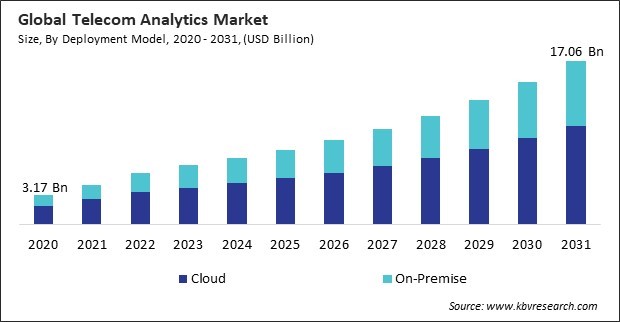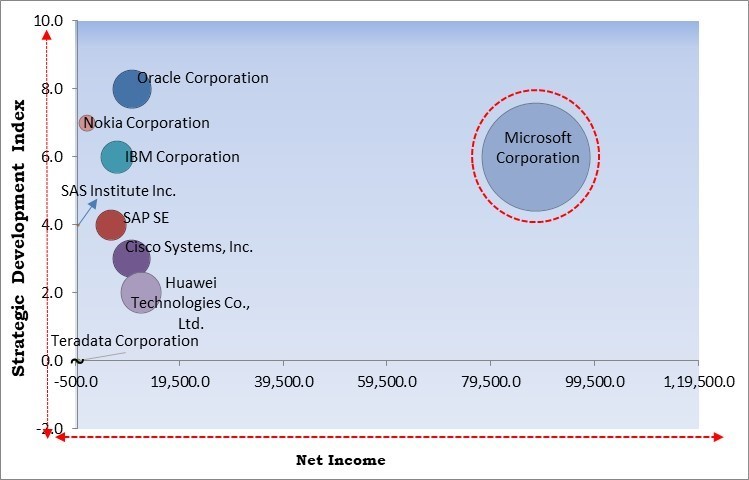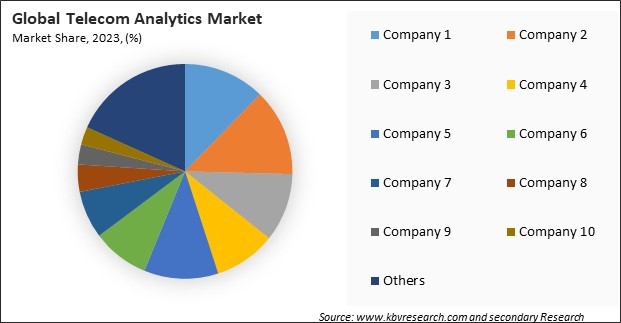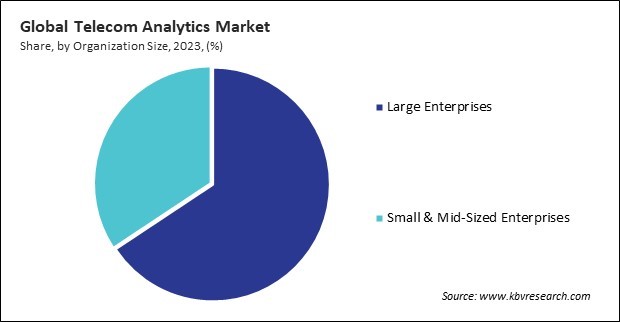“Global Telecom Analytics Market to reach a market value of 17.06 Billion by 2031 growing at a CAGR of 13.7%”
The Global Telecom Analytics Market size is expected to reach $17.06 billion by 2031, rising at a market growth of 13.7% CAGR during the forecast period.
Telecom companies use customer management analytics to analyze customer behavior, preferences, and interactions, enabling them to offer tailored solutions and improve customer support services. Therefore, in 2023, the customer management segment registered 28% revenue share in the market. This segment uses analytics to enhance customer satisfaction, retention, and service personalization. By leveraging these insights, telecom operators can reduce churn, increase customer loyalty, and enhance overall customer experience.

The major strategies followed by the market participants are partnerships as the key developmental strategy to keep pace with the changing demands of end users. For instance, In August, 2024, Oracle Corporation collaborated with AT&T, a global telecommunications company, to integrate AT&T's IoT connectivity and network APIs into Oracle's Enterprise Communications Platform (ECP). This solution simplifies IoT device management by enabling seamless connectivity and real-time data intelligence, benefiting businesses and organizations in industries like telecom, emergency services, and beyond. Additionally, In August, 2024, Huawei collaborated with Indosat Ooredoo Hutchison, an Indonesian digital telecom provider, to launch Southeast Asia's largest Digital Intelligence Operations Center (DIOC). This AI-powered center enables real-time network insights, end-to-end service management, and data-driven innovation, enhancing Indosat's network performance and customer satisfaction for 100 million users.
Based on the Analysis presented in the KBV Cardinal matrix; Microsoft Corporation is the forerunner in the Telecom Analytics Market. Companies such as Huawei Technologies Co., Ltd., Cisco Systems, Inc. and Oracle Corporation are some of the key innovators in Telecom Analytics Market. In September, 2024, Oracle Corporation came into partnership with Amazon Web Services, Inc. (AWS) to introduce Oracle Database@AWS, offering access to Oracle Autonomous Database and Oracle Exadata Database Service within AWS. This integration simplifies enterprise workloads' migration to the cloud, enhancing agility, security, and performance.

As telecom companies prepare for 5G's widespread adoption, they need to invest heavily in advanced analytics solutions to make the most of the new opportunities. Telecom providers can better manage new use cases enabled by 5G, such as smart cities, autonomous vehicles, and industrial IoT, using data analytics. Analytics helps optimize the current network and lays the groundwork for future innovations. This creates a strong push for telecom analytics as a critical tool for operators navigating the 5G landscape. Hence, the rising adoption of 5G technology and its impact on data traffic drive the market's growth.
Customer-centric analytics is also crucial in the context of competition. Telecom providers compete fiercely to attract and retain customers; personalized experiences are a key differentiator. By utilizing advanced analytics, telecom companies can stay ahead of the competition by offering unique, customer-tailored experiences. As this demand for personalization continues to grow, telecom analytics solutions that can harness vast customer data and translate it into actionable insights will be in high demand. Therefore, the growing demand for enhanced customer experience and personalization propels the market's growth.
The cost of maintaining and upgrading analytics solutions can be an ongoing burden. As technology evolves and data volumes increase, telecom companies must continually invest in upgrading their systems to keep pace with new demands. This can create a cycle of continuous financial outlay, deterring some companies from fully embracing the potential of telecom analytics, especially in developing markets with limited resources. In conclusion, the high costs of implementing advanced analytics solutions impede the market's growth.

The leading players in the market are competing with diverse innovative offerings to remain competitive in the market. The above illustration shows the percentage of revenue shared by some of the leading companies in the market. The leading players of the market are adopting various strategies in order to cater demand coming from the different industries. The key developmental strategies in the market are Acquisitions and Partnerships & Collaborations.
Based on deployment model, the market is divided into cloud and on-premise. The on-premise segment held 37% revenue share in the market in 2023. Telecom companies with stringent data security requirements often prefer on-premise solutions. These solutions provide greater control over data management, storage, and security protocols, which is crucial for sensitive or proprietary information. On-premise deployments also allow for a higher degree of customization to meet specific business needs and integrate seamlessly with existing systems and processes within the organization.
On the basis of organization size, the market is segmented into large enterprises and small & mid-sized enterprises. The large enterprises segment recorded 66% revenue share in the market in 2023. Several factors drive this dominance. Large enterprises typically have extensive customer bases and generate massive volumes of data, necessitating robust analytics solutions to effectively manage, interpret, and leverage this information. These enterprises also possess the financial resources to invest in comprehensive analytics platforms, integrating advanced technologies such as AI and machine learning to enhance operational efficiency and customer experience.

Based on component, the market is categorized into solutions and services. In 2023, the services segment witnessed 33% revenue share in the market. This segment plays a pivotal role in successfully deploying, integrating, and maintaining telecom analytics solutions. Services include consulting, system integration, support, training, and managed services, all essential for optimizing telecom analytics platforms' implementation and ongoing operation. Telecom companies often rely on these services to ensure that analytics solutions are customized to their specific needs, integrated with existing infrastructure, and continuously supported for optimal performance.
The solutions segment is further subdivided into network analytics, customer analytics, service analytics, subscriber analytics, location analytics, price analytics, and others. In 2023, the network analytics segment attained 25% revenue share. Network analytics plays a crucial role in optimizing the performance and efficiency of telecom networks. By monitoring network traffic and identifying potential issues in real-time, telecom operators can prevent downtime, improve network reliability, and enhance user experience. Network analytics also helps telecom companies in capacity planning, fault detection, and predictive maintenance, ensuring the smooth functioning of their infrastructure.
By application, the market is divided into customer management, sales & marketing management, network management, risk & compliance management, workforce management, and others. In 2023, the network management segment held 15% revenue share in the market. Network management analytics helps telecom companies monitor and optimize network performance, ensuring efficient service delivery. By analyzing network data, operators can identify bottlenecks, predict potential failures, and optimize traffic management. This application is crucial for maintaining network uptime, improving bandwidth utilization, and enhancing telecom networks' overall reliability and performance.
Free Valuable Insights: Global Telecom Analytics Market size to reach USD 17.06 Billion by 2031

The Telecom Analytics Market is highly competitive, driven by the need for telecom operators to optimize operations, enhance customer experience, and manage growing data volumes. Providers focus on delivering AI-driven analytics, real-time insights, and predictive models to address network optimization, churn reduction, and fraud detection. The market's growth is propelled by increasing adoption of big data technologies, 5G rollout, and digital transformation. Intense competition pushes vendors to offer scalable, secure, and cost-effective solutions tailored to dynamic industry requirements.
Region-wise, the market is analyzed across North America, Europe, Asia Pacific, and LAMEA. The North America region witnessed 38% revenue share in the market in 2023. The dominance of North America in this market is largely driven by the presence of major telecom operators and technology providers actively investing in advanced analytics solutions. The region is characterized by a highly competitive telecom industry, where companies increasingly leverage telecom analytics to enhance network efficiency, improve customer experience, and optimize business operations. The rapid adoption of new technologies such as 5G and the Internet of Things (IoT) further fuels the demand for telecom analytics in North America.
| Report Attribute | Details |
|---|---|
| Market size value in 2023 | USD 6.20 Billion |
| Market size forecast in 2031 | USD 17.06 Billion |
| Base Year | 2023 |
| Historical Period | 2020 to 2022 |
| Forecast Period | 2024 to 2031 |
| Revenue Growth Rate | CAGR of 13.7% from 2024 to 2031 |
| Number of Pages | 353 |
| Tables | 573 |
| Report coverage | Market Trends, Revenue Estimation and Forecast, Segmentation Analysis, Regional and Country Breakdown, Competitive Landscape, Market Share Analysis, Porter’s 5 Forces Analysis, Company Profiling, Companies Strategic Developments, SWOT Analysis, Winning Imperatives |
| Segments covered | Deployment Model, Organization Size, Component, Application, Region |
| Country scope |
|
| Companies Included | Cisco Systems, Inc., IBM Corporation, Oracle Corporation, SAP SE, Microsoft Corporation, SAS Institute Inc., Huawei Technologies Co., Ltd. (Huawei Investment & Holding Co., Ltd.), Nokia Corporation, Teradata Corporation, TIBCO Software, Inc. (Vista Equity Partners Management, LLC) |
By Deployment Model
By Organization Size
By Component
By Application
By Geography
The Market size is projected to reach USD 17.06 billion by 2031.
Increasing Demand for Data-Driven Decision-Making in Telecom Operations are driving the Market in coming years, however, High Costs of Implementing Advanced Analytics Solutions restraints the growth of the Market.
Cisco Systems, Inc., IBM Corporation, Oracle Corporation, SAP SE, Microsoft Corporation, SAS Institute Inc., Huawei Technologies Co., Ltd. (Huawei Investment & Holding Co., Ltd.), Nokia Corporation, Teradata Corporation, TIBCO Software, Inc. (Vista Equity Partners Management, LLC)
The expected CAGR of this Market is 13.7% from 2023 to 2031.
The Solutions segment is leading the Market by Component in 2023; thereby, achieving a market value of $11.18 billion by 2031.
The North America region dominated the Market by Region in 2023; thereby, achieving a market value of $6.27 billion by 2031.
Our team of dedicated experts can provide you with attractive expansion opportunities for your business.

 Drivers
Drivers
 Restraints
Restraints
 Opportunities
Opportunities
 Challenges
Challenges
